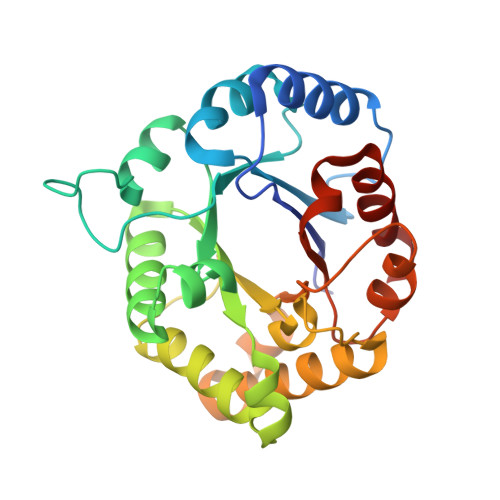Structural Basis for Redox Regulation of Cytoplasmic and Chloroplastic Triosephosphate Isomerases from Arabidopsis thaliana.
Lopez-Castillo, L.M., Jimenez-Sandoval, P., Baruch-Torres, N., Trasvina-Arenas, C.H., Diaz-Quezada, C., Lara-Gonzalez, S., Winkler, R., Brieba, L.G.(2016) Front Plant Sci 7: 1817-1817
- PubMed: 27999583
- DOI: https://doi.org/10.3389/fpls.2016.01817
- Primary Citation of Related Structures:
4OBT, 4OHQ - PubMed Abstract:
In plants triosephosphate isomerase (TPI) interconverts glyceraldehyde 3-phosphate (G3P) and dihydroxyacetone phosphate (DHAP) during glycolysis, gluconeogenesis, and the Calvin-Benson cycle. The nuclear genome of land plants encodes two tpi genes, one gene product is located in the cytoplasm and the other is imported into the chloroplast. Herein we report the crystal structures of the TPIs from the vascular plant Arabidopsis thaliana (AtTPIs) and address their enzymatic modulation by redox agents. Cytoplasmic TPI (cTPI) and chloroplast TPI (pdTPI) share more than 60% amino acid identity and assemble as (β-α) 8 dimers with high structural homology. cTPI and pdTPI harbor two and one accessible thiol groups per monomer respectively. cTPI and pdTPI present a cysteine at an equivalent structural position (C13 and C15 respectively) and cTPI also contains a specific solvent accessible cysteine at residue 218 (cTPI-C218). Site directed mutagenesis of residues pdTPI-C15, cTPI-C13, and cTPI-C218 to serine substantially decreases enzymatic activity, indicating that the structural integrity of these cysteines is necessary for catalysis. AtTPIs exhibit differential responses to oxidative agents, cTPI is susceptible to oxidative agents such as diamide and H 2 O 2 , whereas pdTPI is resistant to inhibition. Incubation of AtTPIs with the sulfhydryl conjugating reagents methylmethane thiosulfonate (MMTS) and glutathione inhibits enzymatic activity. However, the concentration necessary to inhibit pdTPI is at least two orders of magnitude higher than the concentration needed to inhibit cTPI. Western-blot analysis indicates that residues cTPI-C13, cTPI-C218, and pdTPI-C15 conjugate with glutathione. In summary, our data indicate that AtTPIs could be redox regulated by the derivatization of specific AtTPI cysteines (cTPI-C13 and pdTPI-C15 and cTPI-C218). Since AtTPIs have evolved by gene duplication, the higher resistance of pdTPI to redox agents may be an adaptive consequence to the redox environment in the chloroplast.
Organizational Affiliation:
Laboratorio Nacional de Genómica para la Biodiversidad, Centro de Investigación y de Estudios Avanzados del Instituto Politécnico NacionalIrapuato Guanajuato, Mexico; Departamento de Biotecnología y Bioquímica, CINVESTAV Unidad IrapuatoIrapuato Guanajuato, Mexico.














